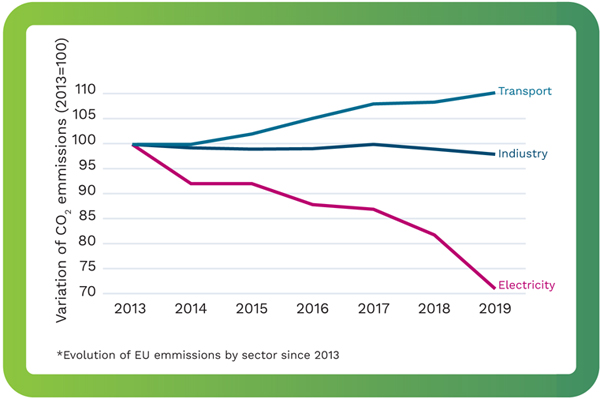From the beginning of time,
the human ability to innovate
and adapt has challenged
the limits of possible and
impossible. Each discovery from fire
to electricity, from steam-powered
to electric vehicles, from ice-cooled
rooms to refrigerators, has shown us
that with the right mind set we could
make disruptors work in our best
interest. Is has happened in the past,
and it can happen again.
The need to cut the alarmingly
high and still mounting greenhouse
gas emissions has triggered a
radical transformation of business
operations around the world. In the
aftermath of the Paris Agreement,
the European electricity utilities
committed to clean up the generation
mix, gradually replacing the fossilfuelled
capacities with carbon-free
sources, such as wind and solar.
Industry-wide assessments have
shown us that it is both technically
and financially possible to have
renewables cover over 80% of
electricity demand by 2045. In this
scenario, a deep decarbonisation
of the power sector, coupled with
increased electrification rates of
heating and cooling, transport and
industry, would enable Europe to
become carbon neutral well before
mid-century.
 The potential of clean sources of
energy has exponentially increased in
light of the promising technological
evolutions that facilitate their
penetration, increase efficiency or
simplify operations and maintenance.
Together with that, the growing
interplay between digitalisation,
decarbonisation and decentralisation,
brings new services and ways to
engage consumers in the energy
transition.
The potential of clean sources of
energy has exponentially increased in
light of the promising technological
evolutions that facilitate their
penetration, increase efficiency or
simplify operations and maintenance.
Together with that, the growing
interplay between digitalisation,
decarbonisation and decentralisation,
brings new services and ways to
engage consumers in the energy
transition.
In the first half of 2020, renewables
covered 34% of the EU electricity mix,
dethroning the fossil fuels for the
first time, and leading to a 23% yearto-
date drop of the CO2 emissions
from the power sector. While some
will attribute these results, in part,
to the COVID-19 black swan event,
for us this is a reflection of an
inexorable trend: the accelerating
decarbonisation process.
Data presented in Eurelectric's
Power Barometer, shows that the
accelerating decarbonisation of
electricity generation, turned the
power sector into the front runner in
the race to cut the CO2 emissions.
At the same time, the transport and
other industrial sectors continued to
emit steadily. But, by ramping up the
uptake of clean electricity, through
direct and indirect electrification,
these energy and carbon intensive
activities, could drastically cut their
emissions.
A recent assessment of the World
Meteorological Organisation has
shown that this year the global CO2
emissions fell between 4.2% and
7.5%, in spite of the high-magnitude
standstill imposed by the COVID-19
pandemic. If economic activities go back to the pre-crisis "normal",
the limit of what can possibly be
absorbed without raising the global
temperatures even more, will be
reached soon. From that point
onward, each calorie produced to
heat our homes and workplaces,
each trip by car or plane, as well as
each meal we cook, would further
intensify the global warming.
The good news is that individuals
and business around the world
are growing more aware of the
negative impacts that keeping
the status quo would have. Their
calls to #BuildBackBetter and
#BuildBackGreener were heard, and
at EU level we have seen a massive
mobilisation of recovery funds, of
which 33% are dedicated to climate
projects while 20% should be
directed to digitalisation.
Digitalisation is a key enabler of
a climate neutral power sector.
Eurelectric's AI Insights: The PowerSector in a Post-Digital Age , a joint
assessment conducted by major
electricity utilities and tech players,
shows us the huge opportunities for
the energy transition, that stem from
the interplay between our sector
and the interconnected exponential
technologies, such as artificial
intelligence and machine learning.
 First, as AI is breaking through
the limits of human capabilities
at just the right time as radical
transformation of the electricity
sector is essential for a cost-effective
clean energy transition. When
looking at electricity generation, AI
has the potential to drive operating
efficiencies, automation and cost
savings. This transformation is
not about replacing the human
component, but more about
augmenting their abilities.
First, as AI is breaking through
the limits of human capabilities
at just the right time as radical
transformation of the electricity
sector is essential for a cost-effective
clean energy transition. When
looking at electricity generation, AI
has the potential to drive operating
efficiencies, automation and cost
savings. This transformation is
not about replacing the human
component, but more about
augmenting their abilities.
An additional benefit of AI
applications in the power sector is
enhanced forecasting, which can
enable a predictive maintenance of
assets, as well as an optimal match
between supply and demand. While
not so long ago, a 24/7 carbon-free
electricity supply was unimaginable,
technological evolutions – including
energy storage, digitalisation and
decentralisation – are bringing it
closer to the realms of possibility.
Second, the growing synergies
between the AI and the power sector
are enabling consumers to play a
key role in the energy transition.
Smart devices, like Alexa or Google
home, allow individuals to manage
their energy consumption based on
desired comfort levels, or to switch
appliances on and off, when power is
expensive.
The increased interaction between
consumers and the power system
serves also as an effective flexibility
solution to ensure the adequate
functioning of a green grid. A better
coordination between the growing
numbers of coordinated devices,
such as smart homes and EVs,
would be essential to enable a
stable and reliable electricity supply,
while phasing out the fossil-fuelled
generation.
A successful coordination depends
on data exchanges between
consumers, suppliers or grid
operators. But privacy concerns
and risks related to data collection,
storage and management still need
to be tackled. Going forward, a
careful balancing act will be required
to manage the potential risks, avoid
bias and safeguard consumer privacy,
while allowing sufficient access to
data and designing regulations that
are robust and effective without
strangling innovation.